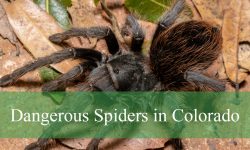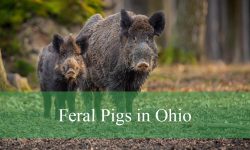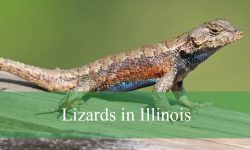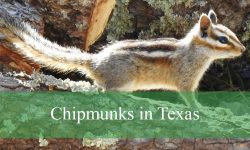Ohio offers a stunning array of birdlife, and among the most striking are the brilliant yellow birds that bring bursts of color to forests, wetlands, and backyards. Their vibrant plumage makes them easy to spot and a joy to identify for anyone with a curiosity for nature.
This guide highlights 9 fascinating types of yellow birds in Ohio, complete with pictures and identification details to help you recognize each species. From the bright American Goldfinch to the secretive Yellow-breasted Chat, these birds are found in a range of habitats throughout the state.
Learning to identify yellow birds in Ohio adds a whole new dimension to your outdoor experiences. With a little attention and the right information, these radiant birds become unforgettable highlights of every walk or birding trip.
Common Yellow Birds Found in Ohio
American Goldfinch
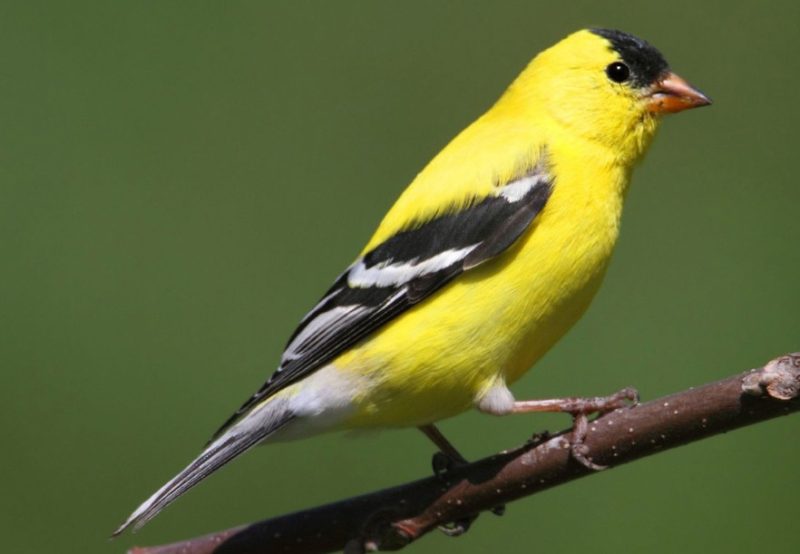
The American Goldfinch is a striking bird, especially during the breeding season when males display a vivid canary-yellow plumage contrasted by a black cap and black wings with white markings. Females, on the other hand, are more subdued, wearing olive-brown tones with duller yellow undersides. Both sexes have conical beaks well-suited for seed eating and a notched tail that aids in quick, darting flight. During non-breeding months, the male’s bright yellow fades into a more muted brownish shade, making seasonal identification important.
This species is commonly found in open habitats throughout Ohio such as meadows, floodplains, fields, and suburban areas with ample wildflowers. They are particularly drawn to areas with thistles, sunflowers, and dandelions. Their fondness for feeders filled with nyjer or black oil sunflower seeds also makes them regular visitors to backyard bird-watching setups. They prefer habitats with sparse tree coverage, as they rely on low-growing plants and tall grasses for nesting and feeding.
American Goldfinches have a sweet, high-pitched song composed of warbles and twitters, often delivered in flight. Their “per-chic-o-ree” call is distinctive and frequently heard as they fly in undulating patterns. These birds are relatively small, measuring about 4.5 to 5 inches in length with a wingspan of 7.5 to 8.7 inches. They primarily eat seeds, especially from composite plants, and are known to breed later in the summer than most songbirds, coinciding with peak seed availability. Their cheerful presence and adaptability make them one of the most beloved songbirds in Ohio.
Yellow Warbler
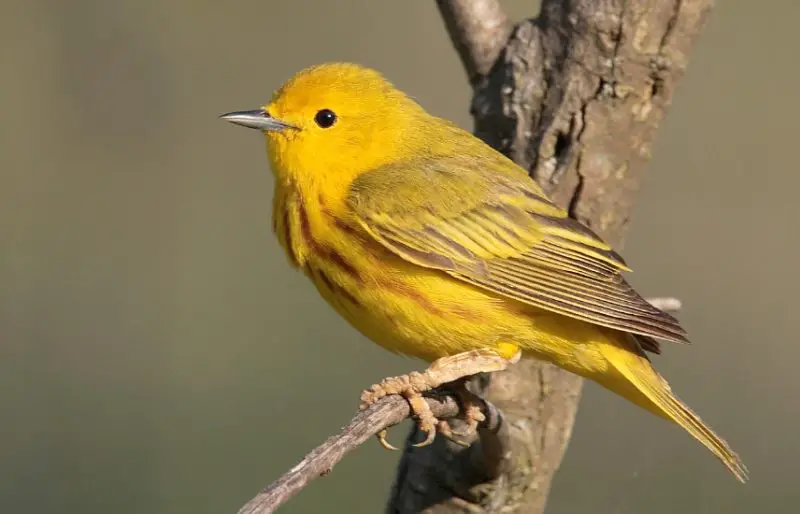
The Yellow Warbler is one of the brightest and most uniformly yellow songbirds in North America. Males are a radiant golden yellow all over, with subtle reddish streaks on the chest that add to their visual charm. Females and immature birds are slightly duller but still maintain a rich yellow tone. Their lack of distinct facial markings and smooth color gradient across the body help distinguish them from other warblers. They are small, slim birds with rounded heads and short, straight bills adapted for insect foraging.
In Ohio, Yellow Warblers favor shrubby wetlands, overgrown fields, willow thickets, and the vegetated edges of streams and ponds. These habitats provide both the dense cover required for nesting and an abundance of insect prey. Their nests are typically built low in shrubs, woven intricately with grasses and lined with downy materials. During spring and summer, their bright plumage stands out against green foliage, making them a delight to spot during birding walks.
Yellow Warblers are renowned for their musical, repetitive song, often transcribed as “sweet-sweet-sweet, I’m so sweet.” Males use this call to defend territory and attract mates, and it can be heard across their breeding grounds from May through July. These birds measure around 4.7 to 5.1 inches in length with a wingspan of 6.3 to 7.9 inches. Their diet mainly consists of insects such as caterpillars, beetles, and flies, which they glean from foliage. Some small fruits and berries are occasionally eaten, especially in the late summer. Yellow Warblers are among the first warblers to migrate south, typically departing Ohio by mid-September.
Common Yellowthroat

The Common Yellowthroat is a small, energetic warbler recognized by its vivid yellow throat and breast, which contrast sharply with its olive-green upperparts. Male birds are easily identified by their bold black facial mask, which stretches from cheek to cheek like a bandit’s mask, bordered above by a white or gray band. Females lack the black mask but retain the yellow throat, though often more muted in tone. Their tails are rounded and often flicked while foraging in low vegetation.
This species thrives in a variety of wet and brushy environments across Ohio. They are particularly common in marshes, damp meadows, weedy fields, and along the edges of streams and ponds. Common Yellowthroats prefer habitats with thick, tangled vegetation that provides cover for nesting and foraging. Their cup-shaped nests are usually hidden in dense grasses or low shrubs. These birds are secretive and often stay hidden in the underbrush, making them more frequently heard than seen.
The call of the Common Yellowthroat is a distinctive and rhythmic “wichity-wichity-wichity,” often repeated in bursts from hidden perches. Males are vocal during the breeding season, using their song to mark territory and draw in females. Measuring about 4.3 to 5.1 inches long with a wingspan of 5.9 to 7.5 inches, these warblers primarily eat insects and spiders, gleaned from leaves and stems. They may occasionally catch small flying insects in mid-air. Though migratory, they are widespread throughout Ohio in summer and are among the most recognizable warblers due to their conspicuous song and colorful plumage.
Yellow-throated Vireo
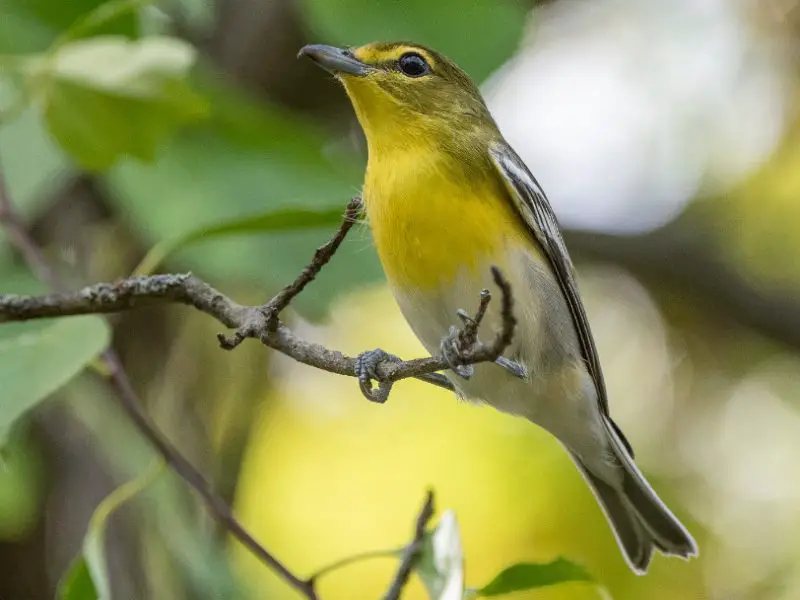
The Yellow-throated Vireo is a vibrantly colored songbird, distinguished by its olive-yellow upperparts, bright yellow throat and chest, and a contrasting white belly. Its most iconic feature is the bold white “spectacles” formed by eye-rings and a white line between the eyes, giving it a distinct and inquisitive expression. The bird’s plumage is subtly shaded, with a blend of soft greens and yellows that help it blend into leafy environments. Its stout bill and relatively stocky body set it apart from similar species such as warblers.
In Ohio, the Yellow-throated Vireo is typically found breeding in mature deciduous forests and mixed woodlands. It favors habitats with tall trees and an open understory, often seen high in the canopy, singing from exposed perches. Migrants can also be spotted in more varied terrain during spring and fall, including hemlock ravines and stream corridors lined with sycamores. These birds prefer territories near water and are more common in forested valleys and upland woods.
This species is known for its slow, deliberate song, a series of burry, repeated phrases that can resemble a hoarse robin: “three-eight, three-eight.” The Yellow-throated Vireo measures about 5.1 to 5.9 inches in length with a wingspan of around 9.1 inches. It primarily feeds on insects such as caterpillars, beetles, and wasps, which it gleans from foliage, but it may also consume berries and small fruits, especially during migration. Though not as numerous as other vireos, its bright throat and persistent song make it a notable species for birdwatchers throughout Ohio’s forested regions.
Prothonotary Warbler
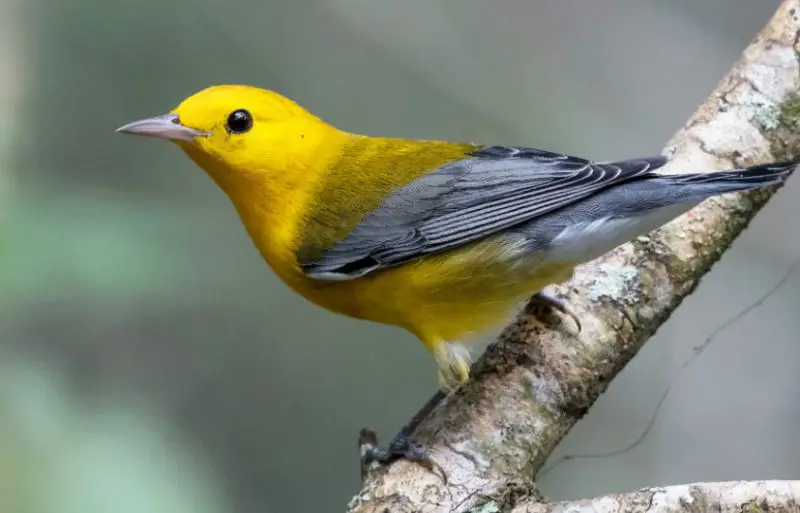
The Prothonotary Warbler is a brilliant and eye-catching species, showcasing a rich golden-yellow head, chest, and underparts, which contrast beautifully with its blue-gray wings and tail. It has dark eyes set in a yellow face and lacks prominent streaks or facial markings, giving it a smooth and glowing appearance. Its name references the yellow robes worn by Catholic clerks, and fittingly, it has a regal presence when seen flitting through swamp forests and river bottoms.
This bird is a specialist of swampy and flooded woodlands, especially those with standing water and abundant trees. In Ohio, it is primarily found in the southern and western parts of the state during breeding season, where it nests in tree cavities just above water, often taking advantage of old woodpecker holes or artificial nest boxes. Prothonotary Warblers require forested wetlands for foraging and nesting, making them more restricted in range compared to other warblers.
The song of the Prothonotary Warbler is a loud, ringing series of “sweet-sweet-sweet-sweet” notes, often repeated and echoing through the swampy woods. Measuring about 5.1 inches long with a wingspan of 8.5 inches, it feeds mostly on insects and aquatic invertebrates, including spiders, beetles, and mayflies. Occasionally, it may consume snails and seeds. Its unique combination of color, song, and habitat preference makes it a prized sighting for birders in Ohio’s wetland preserves and bottomland forests.
Yellow-breasted Chat
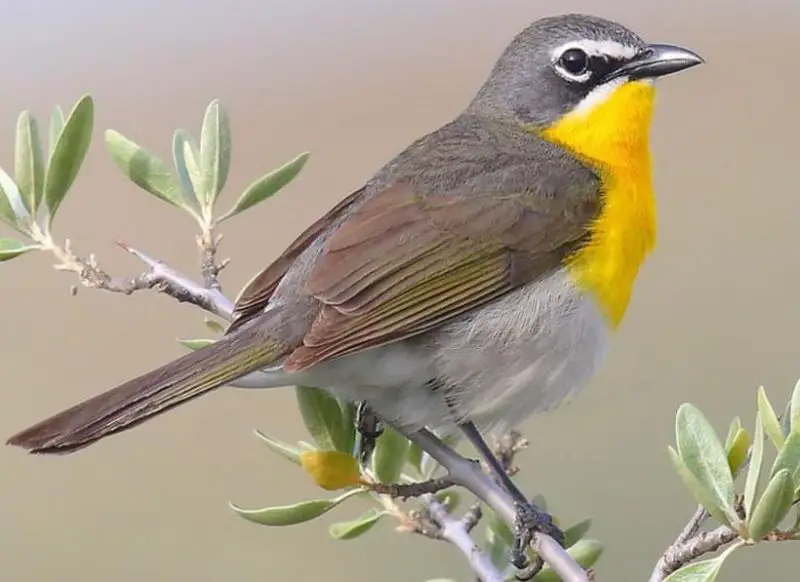
The Yellow-breasted Chat is the largest of the North American warblers and is easily recognized by its robust body, olive-green upperparts, and vivid yellow throat and breast. It has a bold white “spectacle” around the eyes and a long tail that often flicks nervously as it moves through dense thickets. Despite its size, the bird’s skulking habits and secretive nature can make it hard to observe closely, as it prefers staying hidden in heavy vegetation.
In Ohio, the Yellow-breasted Chat inhabits dense shrubby areas, regenerating clearings, overgrown fields, and hedgerows, often near water or within abandoned farmland. It avoids deep forests in favor of open or early-successional habitats where it can forage low and nest within thick, brushy cover. It builds a bulky, cup-shaped nest in dense shrubs, typically less than ten feet above ground.
This species is famous for its varied and often bizarre vocalizations. Its song includes whistles, cackles, gurgles, and harsh notes that are sometimes imitated from other birds. Chats often sing from concealed perches, but males may briefly perch in the open to perform flight displays during the breeding season. Measuring 7.1 inches long with a wingspan of up to 9.8 inches, the Yellow-breasted Chat feeds on a wide range of insects and spiders and supplements its diet with berries and small fruits. Though once classified as a warbler, its unique behaviors and size have led to its placement in its own family, making it a fascinating bird of Ohio’s wilder edges.
Other Yellowish Visitors (Less Common)
Baltimore Oriole
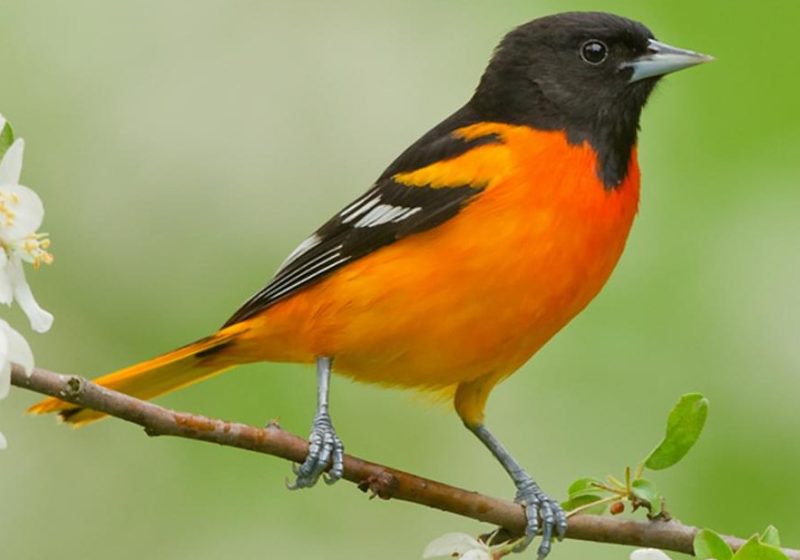
The Baltimore Oriole is a strikingly colorful bird that stands out with its vibrant orange-yellow body contrasted by a deep black head, back, and wings in adult males. Females and immature birds are more subdued in color, typically sporting olive-yellow bodies with grayish or duller orange tones. A key identification feature is the white wing bars seen in both sexes, and their slender, slightly curved bill helps distinguish them from other similar songbirds. Their overall posture and long tail also add to their elegant appearance.
In Ohio, Baltimore Orioles are common summer residents, particularly in open woodlands, forest edges, city parks, and suburban areas with tall deciduous trees. They are especially attracted to fruiting trees such as mulberry and cherry, and are known for visiting backyard feeders offering orange halves or grape jelly. These orioles build remarkable hanging nests, woven from plant fibers and suspended from the tips of tree branches—often high up and difficult to spot unless actively being used.
Baltimore Orioles have a clear, whistling song that sounds flutelike and cheerful, typically composed of short, paired notes. Their call is a distinctive chatter or scold, which may alert you to their presence. Measuring about 7 to 8 inches long with a wingspan of 11 to 12 inches, these birds primarily feed on insects, fruits, and nectar. Insects make up the bulk of their diet during the breeding season, while sugary foods become more important during migration and late summer. Their vivid color and musical song make them a favorite among Ohio birders.
Golden-winged Warbler
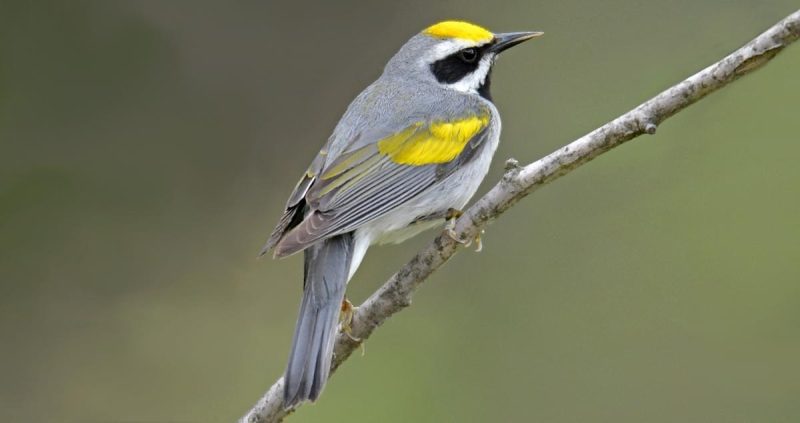
The Golden-winged Warbler is a small, delicate warbler known for its refined and crisp plumage. It features a pale gray body accented by bold yellow wing patches and a bright yellow crown. Its face has a distinctive black mask and throat, bordered by white that highlights the yellow. This clean, sharp appearance makes it one of the more easily identified warblers for those fortunate enough to spot one. Males are more brightly marked, while females and juveniles appear slightly muted with less contrast.
This warbler is increasingly rare in Ohio but may still be seen during migration or in scattered breeding habitats in the northeast and southern edges of the state. It prefers shrubby wetlands, regenerating clear-cuts, and edges of woodlands where young trees and dense undergrowth are abundant. Unfortunately, the species has declined significantly due to habitat loss and hybridization with the closely related Blue-winged Warbler, limiting its range and population.
The Golden-winged Warbler has a buzzy, insect-like song, often described as “bee-bzz-bzz,” which it delivers from perches within shrubby thickets. It is one of the smallest warblers, measuring about 4.7 inches in length with a wingspan of 7.5 inches. Its diet consists mostly of insects, including caterpillars, spiders, and beetles, which it gleans from leaves and branches. The bird’s rarity, subtle beauty, and fragile conservation status have made it a priority species for habitat restoration projects across its eastern range, including select locations in Ohio.
Yellow-headed Blackbird
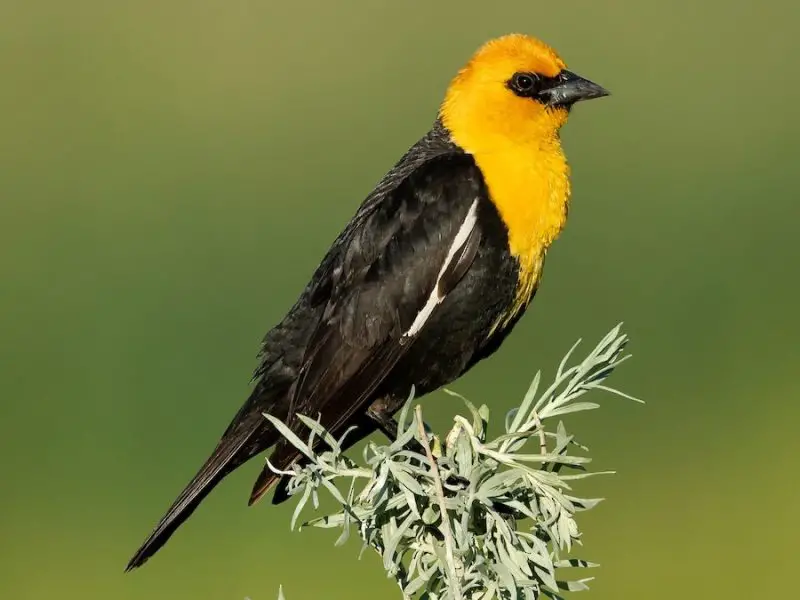
The Yellow-headed Blackbird is a bold and unmistakable marshland species with dramatic plumage. Adult males feature a deep black body and wings, offset by a bright yellow head and chest that gives the bird its name. A striking white wing patch is visible during flight. Females and immature birds are more brownish with duller yellow coloring, but they still display the characteristic color pattern. This blackbird’s chunky build and strong bill give it a powerful appearance, especially when perched atop cattails or reeds.
In Ohio, the Yellow-headed Blackbird is considered an uncommon breeder and a rare migrant, mostly seen in the northwestern part of the state. It favors large, permanent wetlands with thick stands of cattails, bulrushes, or reeds, where colonies of birds may nest and forage. These marshes provide safety and ample food, and males are often seen calling from exposed perches while defending their nesting territories.
The species’ call is a loud, grating, mechanical-sounding buzz—often compared to a rusty farm gate or robot-like screech—which is very distinctive and audible across the wetland. These blackbirds grow up to 9 to 10 inches long with a wingspan of 16 to 17 inches. They feed primarily on insects during the breeding season, including aquatic larvae and beetles, and switch to seeds and grains in the fall. Though less widespread than the more common Red-winged Blackbird, the Yellow-headed Blackbird’s dramatic colors and harsh voice make it an unforgettable sight in Ohio’s larger marshes.


